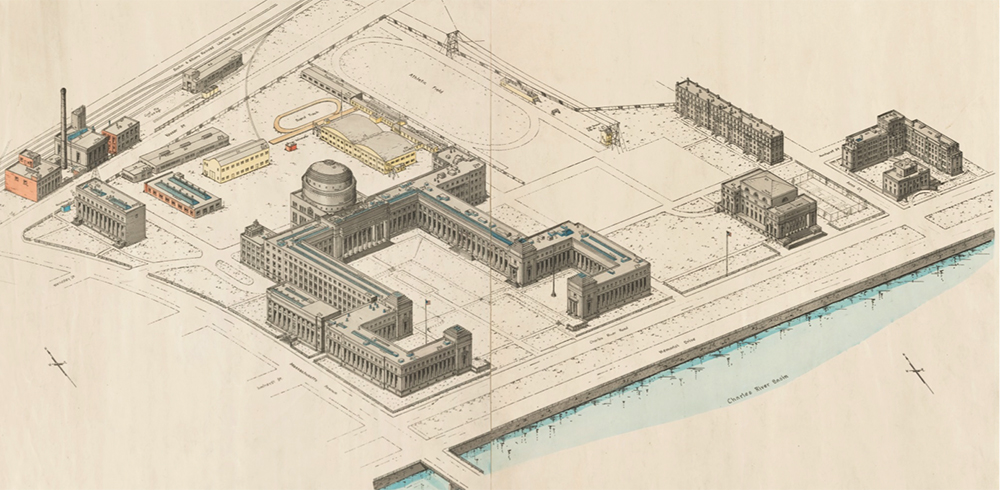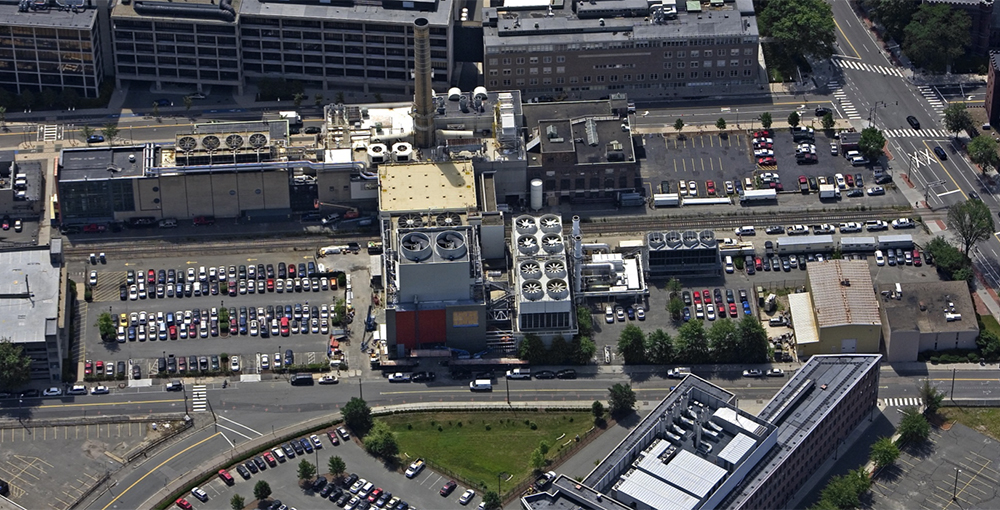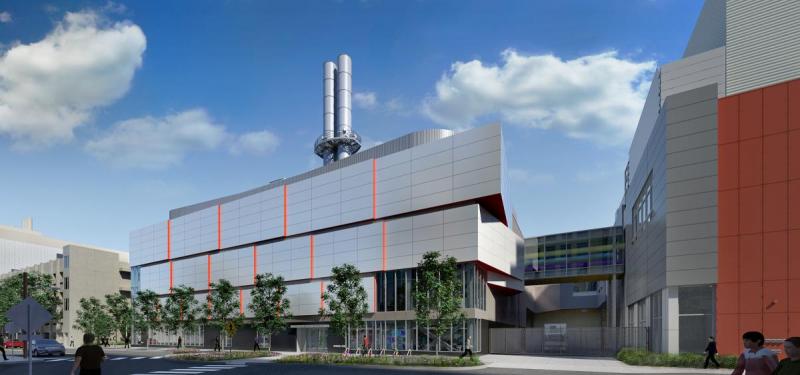Past, present, and future
The upgrade of the Central Utilities Plant represents just one of the pivotal measures pursued by MIT during its 100-year history of on-campus energy in Cambridge.
- 1916: When building the campus, MIT includes a state-of-the-art district steam and electrical power plant. This coal-powered central facility is a cleaner, more efficient choice compared with individual coal furnaces in all campus buildings. MIT locates the plant next to the existing Grand Junction Railway to streamline the delivery of coal from rail cars into plant storage. (This 1929 drawing of the MIT Cambridge campus shows the Utilities Plant in the upper left corner, located along the railroad tracks.)

- 1935: MIT transitions from coal to oil as a cleaner primary fuel, beginning a long-term practice of transitioning to higher-grade fuel options when possible.
- 1938: Noting that the local public utility’s electricity grid has become more robust and reliable, MIT begins purchasing electric power from the utility.
- 1973: The global oil crisis kicks off more than a decade of high oil prices and price volatility. In light of this and the declining reliability of the utility’s aging power grid, MIT begins to reevaluate its power supply options in the late 1980s.
- 1995: Operations begin at MIT’s new on-campus cogeneration facility, increasing campus efficiency and reducing emissions.
- 2006: Pursuant to the 2006 Report of the Energy Research Council commissioned by MIT President Susan Hockfield, MIT launches the MIT Energy Initiative (MITEI). MITEI creates a new platform for highly focused energy-related activity, including multidisciplinary research, outreach and education, and ongoing efforts to achieve a more energy-efficient campus.
- 2009: Under the MITEI umbrella, the Campus Energy Task Force launches the “Greening MIT” campaign to help reduce the Institute’s energy footprint. During its first five years, the campaign results in substantial energy savings and inspires alumni to establish an energy-efficiency investment fund to support future projects.
- 2010: MIT and utility company NSTAR (now Eversource Energy) embark on the Efficiency Forward program, a groundbreaking collaboration to reduce energy use at MIT. In the first phase of this partnership (2010-2012), campus electricity use is reduced by a total of 34 million kWh – comparable to annual electricity use in 3,000 homes.
- 2010: MIT completes the Koch Institute for Integrative Cancer Research (Building 76), which uses 35% less energy than required by code and achieves LEED Gold certification.
- 2010: The new Sloan School of Management building (Building E62) is completed and achieves LEED Gold certification, using 45% less energy than required by code.
- 2012: Efficiency upgrades in Building 46 reduce campus energy use by more than 1.6 million kWh annually – just one example of how ongoing Efficiency Forward energy efficiency measures are helping MIT reduce energy use in existing buildings as well as new construction.
- 2012: Phase 2 of the Efficiency Forward program launches, establishing a portfolio of measures designed to save an additional 21 million kWh annually (above energy savings already achieved).
- 2013: MIT establishes the Office of Sustainability, connecting the Institute’s administrative, research, and educational branches in a collaborative effort to establish, evolve, and model leading sustainability practices on campus.
- 2014: Through its Conversation on Climate Change, MIT seeks broad input about global climate change and to explore pathways to effective climate change mitigation.

Aerial view of CUP (above) - 2015 (June): The MIT Climate Change Conversation Committee submits findings to MIT executive leadership.
- 2015 (October): MIT releases its Plan for Action on Climate Change, committing to a greenhouse gas emissions reduction of at least 32% by 2030 and establishing a plan for eight new Low-Carbon Energy Centers to enable new energy research.
- 2015 (December): MIT initiates permit reviews for the Central Utilities Plant upgrades.
- 2016: MIT enters into a groundbreaking aggregate power purchase agreement, committing to buying 73% of the power generated at a new 60-megawatt solar farm in North Carolina. This purchase neutralizes 17% of MIT's carbon emissions.
- 2020: The upgraded Central Utilities Plant is scheduled to be completed.
